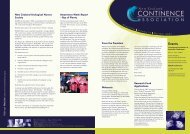Continence Assessment Form and Care Plan RESIDENT ID 1
Continence Assessment Form and Care Plan RESIDENT ID 1
Continence Assessment Form and Care Plan RESIDENT ID 1
You also want an ePaper? Increase the reach of your titles
YUMPU automatically turns print PDFs into web optimized ePapers that Google loves.
SECTION B: Bladder & Bowel pattern (continued)<br />
<strong>Assessment</strong> Cues<br />
(tick appropriate response)<br />
11. Does the resident experience urine<br />
leakage during the day?<br />
■ Yes<br />
■ No<br />
If yes, how often?<br />
■ Once every few days<br />
■ Once a day<br />
■ Several times a day<br />
■ Most or every time<br />
12. Does the resident experience urine<br />
leakage during the night?<br />
■ Yes<br />
■ No<br />
If yes, how often?<br />
■ Once every few nights<br />
■ Once a night<br />
■ Several times a night<br />
■ Most or every time<br />
13. Does the resident have a predictable<br />
pattern of passing urine (including urine<br />
leakage) ?<br />
a) During the day?<br />
■ Yes<br />
■ No<br />
b) During the night?<br />
■ Yes<br />
■ No<br />
<strong>Care</strong> Options<br />
(tick appropriate care option)<br />
If yes to urine leakage during the day:<br />
■ Develop <strong>and</strong> put in place an individualised toileting program<br />
■ Develop <strong>and</strong> put in place a fixed time toileting program<br />
■ Develop <strong>and</strong> put in place a pad check <strong>and</strong> change program<br />
If yes to urine leakage during the night:<br />
■ Develop <strong>and</strong> put in place an individualised toileting program<br />
■ Develop <strong>and</strong> put in place a fixed time toileting program<br />
■ Develop <strong>and</strong> put in place a pad check <strong>and</strong> change program<br />
If yes:<br />
■ Refer to the 3 day bladder chart <strong>and</strong> use the grid below to mark the times for an individualised<br />
toileting program based on the resident’s pattern.<br />
If no:<br />
■ Use the grid below to mark the times for a fixed time toileting program<br />
(i.e. at least every 4 - 6 hours during the day)<br />
■ Use the grid below to mark the times for a pad check <strong>and</strong> change program<br />
(i.e. at least every 4 - 6 hours during the day)<br />
Toileting / pad check <strong>and</strong> change grid (please tick)<br />
midnight<br />
1<br />
am am 2<br />
am 3<br />
am 4<br />
am 5<br />
am 6<br />
am 7<br />
am 8<br />
am 9<br />
am 10<br />
am 11 12<br />
noon<br />
1<br />
pm pm 2<br />
pm 3<br />
pm 4<br />
pm 5<br />
pm 6<br />
pm 7<br />
pm 8<br />
pm 9<br />
pm 10<br />
pm<br />
11<br />
Toileting times<br />
Pad check<br />
& change times<br />
<strong>Assessment</strong> Cues<br />
(tick appropriate response)<br />
14. Does the need to pass urine or<br />
incontinence at night make it difficult for<br />
the resident to go back to sleep?<br />
■ N/A<br />
■ No<br />
■ Sometimes<br />
■ Yes<br />
<strong>Care</strong> Options<br />
(tick appropriate care option)<br />
If sometimes or yes:<br />
■ Place a commode beside the resident’s bed.<br />
■ Offer the resident a bedpan or urinal.<br />
■ Identify <strong>and</strong> put in place individualised strategies to help the resident to return to sleep<br />
Developed by Deakin University <strong>and</strong> funded under the National <strong>Continence</strong> Management Strategy<br />
3




